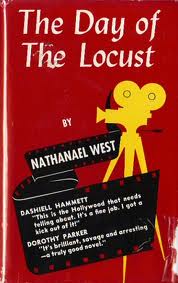The Day of the Locust: Difference between revisions
Pawl Kennedy (talk | contribs) links for years as appropriate; wikify date |
Procrustean (talk | contribs) |
||
| Line 46: | Line 46: | ||
*[[Y: The Last Man]] |
*[[Y: The Last Man]] |
||
*[[Six Feet Under]] |
*[[Six Feet Under]] |
||
{{ Nathanael West}} |
{{ Nathanael West}} |
||
Revision as of 18:07, 21 November 2007
 1939 first edition cover | |
| Author | Nathanael West |
|---|---|
| Language | English |
| Publisher | Random House |
Publication date | May 16 1939 |
| Publication place | United States |
| Media type | print, Hardcover, Paperback |
| Pages | 238 p. |
| ISBN | 978-0451523488 |
The Day of the Locust is a 1939 novel by American author Nathanael West, set in Hollywood, California during the Great Depression, depicting the alienation and desperation of a disparate group of individuals whose dreams of success have effectively failed.
The novel was adapted for the screen in 1975.
Major characters
The characters in West's novel represent the actors, artists, businessmen, dreamers and vagabonds West met while working as a screenwriter in 1930s Hollywood. And so, all of the characters in Day are outcasts who have come to Hollywood in search of something or another. For the most part, West's characters are intentionally shallow and iconic, and "…derive from all the B-grade genre films of the period…" (Simon, 523). West's characters are Hollywood stereotypes, and West's portrayal of these stereotypes is most often absurdly hyperbolic.
The novel's protagonist, Tod Hackett (a play on the German word for "death" and the tendency of Hollywood insiders to refer to their writers and artists as "hacks"), is a set painter who aspires to artistic greatness. In the first chapter of the novel, the narrative voice announces: "Yes, despite his appearance, [Tod] was really a very complicated young man with a whole set of personalities, one inside the other like a nest of Chinese boxes. And 'The Burning of Los Angeles,' a picture he was soon to paint, definitely proved he had talent." Tod's painting, then, is a metaphor for West's novel, marking Tod Hackett as representative of West himself.
Over the course the novel, we are introduced to several minor characters, each corresponding to a given Hollywood trope. There is Harry Greener (the fading Vaudevillian) and his daughter, Faye (the starlet), Claude Estee (the big-time producer), Homer Simpson (the hopelessly clumsy "everyman" — an unfortunate, uncouth ‘Schlemiel’ like Lemuel Pitkin in A Cool Million with a touch of Miss Lonelyhearts' crypto-religious manic-depression; the name of the animated character Homer Simpson is an homage), Abe Kusich (the diminutive, yet vicious gangster), Earle Shoop (the cowboy) and Miguel the Mexican (his sidekick), Adore Loomis (the child star/prima donna) and his mother (the doting stage-mother).
The narrative voice follows either Tod or Homer through most of Day, with the reader experiencing the bizarre and grotesque world of 1930s Hollywood through their eyes. The novel is essentially episodic, with each episode either introducing a character or highlighting interactions between one character and another. These interactions are just as cliché as the characters; at one point in the novel, Abe picks a fight with Earle; at another, Harry shows up at Homer's doorstep, desperately trying to sell him silver polish. Tod, Claude, Homer, Abe, Earle and Miguel all pursue Faye in turn; each in their own stereotypic manner.
Works cited
- Simon, Richard Keller (1993). "Between Capra and Adorno: West's Day of the Locust and the Movies of the 1930s". Modern Language Quarterly. 54 (4): p. 524.
{{cite journal}}:|pages=has extra text (help)
Referenced in
- Death Cab for Cutie-Why You'd Want To Live Here?
- Y: The Last Man
- Six Feet Under
